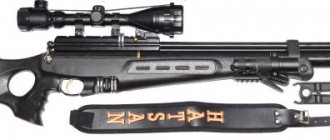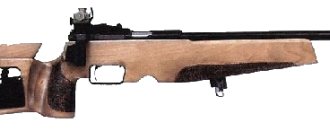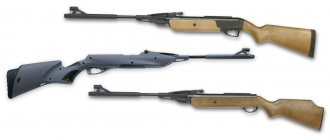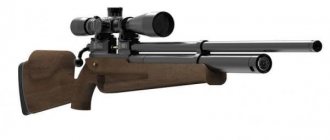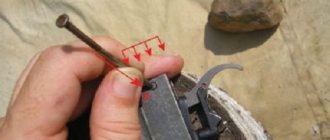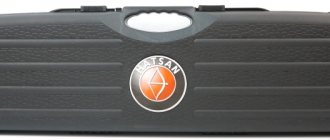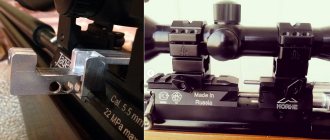When you get acquainted with the Condor air rifle, produced by the North American arms company Airforce, you experience mixed feelings. First of all, delight. Epithets and associations are selected accordingly. For example, the “elephant knocker” or the favorite rifle of Colonel Moran, the enemy of Sir Sherlock Holmes and his friend Dr. Watson. Secondly, doubt - I really want such a toy, but where can I use it? After all, this is a real weapon - at a distance of two hundred meters it smashes a bottle into dust!
Review of the AirForce Condor air rifle
it is a single-shot pre-pumped rifle (PCP). Between the gas cylinder and the barrel there is only the trigger mechanism and the charging chamber. Something similar, which confirms the maxim about the “well forgotten old,” was created at the beginning of the 19th century by the Austrian gunsmith Girardoni. The only modern things about Airforce Condor are modern materials and modular design, which allows you to create exclusive weapons with unique technical characteristics on its basis.
Advantages and disadvantages
Technically the rifle is very simple. Structurally, it consists of two pipes of different diameters (one of them is the barrel), an aluminum frame onto which the cylinder is screwed (if the standard one is not enough for you, you can use a larger one), a pistol grip, a bracket for optics, a plastic forend and a trigger mechanism. The Airforce company released it as a “semi-finished product”. That is, you can already shoot from it, but the owner is free to modernize it as he pleases.
The stock 4.5 mm rifled barrel can be replaced with 5.0, 5.5 and even 6.35 mm. The rifle in its original form does not have a stock - instead there is only a semblance of a butt plate on a cylinder, a pistol grip and a forend. Nowadays, many companies specialize in making stocks for such rifles, but you can make them yourself. Exclusive guaranteed!
The upper bracket is a seat for optical sights. Its width is 11 mm. Type – Weaver bar. Considering that the recoil when firing is very small, any sights can be installed.
In general, the stock version of Airforce Condor is a modular set of elements that can be replaced like parts of a construction set.
In its original form, the rifle is not too heavy - three kilograms, and the length is only 980 mm. It is smaller and lighter than, for example, Hatsan spring-piston rifles. However, it is equipped with a bipod, which increases ease of use.
The rifle is very powerful, the shot energy is more than 50 joules! And its strength can be adjusted by changing the force of the striker spring. This is an advantage, but as a technical product. It also makes it very dangerous, and therefore practically inapplicable as a popular tool for entertainment - shooting at cans, bottles and pretending to be Chingachgook or Nathaniel Bumppo.
A half-liter gas cylinder not only adds weight, but also makes this rifle a special sporting equipment - it requires at least five hundred movements to inflate it with a hand pump. It is doubtful that on the day of refueling you will also want to shoot.
Scope of application
Of course, you can make it the “highlight” of a country picnic. But it is more advisable to use this rifle for sport shooting at a shooting range (preferably at a shooting range) and for hunting.
Photo of the Airforce Condor air rifle
Airforce Condor – PCP rifle from the USA
No one has anything like it yet. Well, except for the manufacturer of Airforce Condor, the American company AirForce Guns.
“The design is very laconic and strict. Nothing extra. Outwardly very reasonable."
From the guns.ru forum
Design
The rifle is somewhat reminiscent of a “water gun”, an English “Sten” submachine gun from the Second World War. There is no hint of classicism, three pipes of different diameters, an iron frame, also known as a butt and a cylinder holder, a pistol grip and a plastic forend. Trigger. On top there is a universal mount for optics. That's all that is visible from the outside.
As you know, everything new is well forgotten old. The design is simple. The frame is made of aluminum and is not a buttstock; the function of the buttstock is performed by the reservoir. Operating principle: from a cylinder previously inflated with air, a portion of air is released through the valve when the trigger is pressed. This portion of air pushes the bullet out. All. This is exactly how air rifles were made back in the days of Napoleon (the famous Giardoni system rifle). Experts call such weapons pneumatic with pre-pumping or PCP (Pre-Charged Pneumatics). Charging the cylinder in such weapons is carried out from compressed air cylinders or high-pressure hand pumps with ordinary air.
The inside of the rifle is even simpler than the outside. The release valve that pushes the bullet out is also the charging valve for refilling the high pressure cylinder. Power regulator and trigger mechanism. All! Single shot rifle. There is so much “dope” in the rifle that with maximum power in a 4.5 mm caliber. You can only shoot accurately with special super-heavy bullets; all the others fly out of the barrel at supersonic speed and begin to tumble in the air.
So what did the Americans do that made everyone call the Condor rifle revolutionary? Well, of course, we carried out a noisy advertising campaign. They set a reasonable price (in the USA from $530). The rifle is made so “modular” that with the help of special “kits” (tuning kits) you can change almost everything in the rifle. There are no factory kits for modernization; everything is semi-homemade, produced in small batches.
Barrel, cylinder, handle, rammer lever, fore-end, butt. The barrel is easily unscrewed and you can install any barrel, even a different length, even a different caliber, there is no thread on the barrel, the barrel is pressed with 4 countersunk screws using two centering bushings. The outer diameter can be anything within reasonable limits. And with each upgrade you get practically a different weapon!
“For a hunter, I don't know if there is anything better than the Sumatra 6.35mm... Although, I will always say Condor because of its platform flexibility...”
From the guns.ru forum
Specifications:
- Available in calibers 6.35 / 5.5 / 5.0 / 4.5 mm
- Type: PCP
- Speed (depending on the position of the power regulator) (m/s): from 70 to 390 and above
- Muzzle energy (J): up to 55
- Overall length (mm): 984 as standard
- Barrel length (mm): 610 as standard
- Weight (kg): 2.96
- Operating pressure 200 bar
- Accuracy – 2.5 cm at 68 m
- Safety: automatic
- Release: adjustable
- Shot mode: single
- Cocking/reloading method: bolt action
- Tank volume 490 cm3 with pressure gauge and quick connector for air filling
Advantages
Power. Today the rifle is considered one of the most powerful in caliber up to .45 (11.5 mm) and the most powerful in caliber 5.5 mm. With such power, heavy 5.5 mm bullets easily break bottles at a distance of over 200 m! Let me remind you, the rifle is an air rifle!
Accuracy. Single-charge systems are generally more accurate than multi-charge systems in principle. Plus, the Condor rifle has a fairly reliable barrel mount at three points... The premium LW match barrels that are installed on these rifles twist the bullet more strongly at high speeds, which also contributes to high-precision shooting. The automatic firing valve is discussed above.
The rifle can shoot not only bullets, but also:
- special darts, which are placed directly into the barrel before firing;
- special syringes for immobilizing animals.
Amazing flexibility. Only the caliber of the barrels can be changed from 4.5 to 11.5 mm. The length of the installed barrel is not regulated in any way.
The ramfire rifle is amazingly accurate.
The power regulator has 12 adjustable positions to change the tension of the hammer spring. The regulator is not fixed in any way, because it is just a nut on a threaded bushing, by rotating which you can change the amount of spring pressure, and with it the force with which the spring hits the valve with the striker. The harder it hits, the larger the cross-section the valve opens, the more compressed air gives off its energy to the bullet.
A huge supply of air in a cylinder mounted in the butt. With a minimum power of 4.5 mm caliber, the pressure in the cylinder is enough for more than 200 full-fledged shots.
The price is quite affordable.
The rifle's receiver is equipped with a special interface strip that allows the installation of a huge number of accessories such as a laser designator, bipod, etc.
Airforce Condor is available in three colors - black, blue and red.
Flaws
Very loud gunshot sound. A muffler is not provided for the basic configuration, but there are versions with a proprietary suppressor built into the frame. There are also homemade moderators.
In current versions of the rifle, both a pressure gauge and a quick-fill port have appeared; they are built into the valve body. Previously, these shortcomings were eliminated with homemade modifications.
Single charge. Although for some this is not a disadvantage...
Conclusion
Airforce Condor is a very high-flying bird. The system is not only revolutionary, but also very interesting! Especially for lovers of extreme power, accurate shots at long distances, as well as for those who like to tune and remake their weapons.
Materials from the site were used.
( 8 votes, average: 4.63 out of 5)
Specifications
Technical characteristics of the AirForce Condor air rifle:
| Characteristics | Indicators |
| Mechanism type | With pre-pumping (PCP) |
| Caliber, mm | 4.5 / 5 / 5.0 Can be increased to 6.35 |
| Trunk | Steel, rifled (12 trapezoidal), replaceable |
| External diameter of the barrel, mm | 16 |
| Barrel length, mm | 610 |
| Shooting mode | Single |
| Ammunition | Heavy lead bullets (1.4–1.8 grams), darts, immobilizing syringes |
| Initial shot speed, m/s | Adjustable, 70–390 and above |
| Shot power, J | 20–90 |
| Cylinder volume, ml | 500 |
| Gate | Sliding, bolted |
| Fuse | Auto |
| Optics rail | Yes, Weaver, 11 mm |
| Length, mm | 984 |
| Weight (caliber 4.5 mm), kg | 2,96 |
And a whole ATV is not enough: test drive the Sider Condor 800 buggy
It all starts with a project
Somehow it happened historically that most of our buggies are foreign cars.
But we need to be in trend, so import substitution is our choice. And today we will look at an interesting example of domestic products produced in St. Petersburg at the Buggy Center enterprise. And it is from the factory that we will begin our acquaintance. In general, the history of the enterprise began with the sale of Chinese cars. They not only sold them, but also tried to improve them in every possible way. Over time, the understanding came that nothing could be improved endlessly, even the “Chinese”. And then the time for creativity came, but I admit: I did not expect such an approach to creating a buggy in a small, small-scale production.
Probably, many have read stories on the Internet about how Kulibin made a buggy or some kind of “cutlet” by eye, and he liked the process of welding on the floor of his garage so much that after his first experience, he began making similar equipment to order. Sometimes something good comes out - at least, both the creator of the design and his few customers are sure of this.
In fact, such machines usually have many shortcomings, and the root of all evil lies in one simple fact: garage designers skip the design process, doing everything on a whim and according to the “fit or fail” principle. If it doesn’t fit, then you can file something down, and then it will definitely fit. I have seen such structures of varying degrees of viability, and therefore I would not be very surprised to hear a story about how they managed to assemble something of their own from pipes and ready-made units from motorcycles and cars. But I was very wrong.
The development of the Sider Condor 800 began with defining the tasks that the future car was required to perform. It should not only drive off-road, but also be as practical as possible. It must have good cross-country ability, it must be easy to control, and it must be able to carry at least some amount of cargo.
Having decided on the concept of the future car, we began to select a power unit. It was the Chinese Odes engine, well known to ATV and motorcycle enthusiasts. We’ll talk about its characteristics later, but for now let’s return to the history of the creation of the buggy. So, we chose the engine. After that, it was scanned with a 3D scanner, obtaining a three-dimensional image of the unit. Now, using the SolidWorks software package, it was possible to begin developing the frame and suspensions. At the same time, SolidWorks allows you to trace the kinematics of mechanisms in the smallest detail. The result is a complete computer model of the future car. In words, of course, everything is much simpler and faster than in life, but the principle is clear: no intuition, straightening with a sledgehammer or filing on the spot.
Production itself
The entire staff of the enterprise is 15 people. And there are enough of them to slowly build up to 10 cars per month, although if you wish, you can make three cars in two days. And this is largely achievable thanks to the correct organization of production.
Assembling the buggy begins with the frame. It is made of seamless cold-drawn pipe, which, coupled with a well-developed design, allows for excellent rigidity with a low frame weight (about 140 kilograms). The frame is assembled on a slipway, where all the finished elements are placed and secured by welding. After this, the frame is removed from the slipway and boiled. Then it is processed, equipped with a handle for the passenger (a very necessary thing, I tell you!), a spare wheel bracket and other little things.
Engines, gearboxes, gearboxes are already waiting in the warehouse - everything that is purchased ready-made or made to order at third-party enterprises. The buggy is sent for assembly.
Previously, they were also involved in stamping plastic body parts, but then they abandoned this process: contractors will do no worse, not much more expensive, and there will be less unpleasant odors.
The buggies are assembled by hand, of course. Setting up a conveyor belt for small-scale production is expensive and unprofitable, especially since you often need to assemble a car to order, with a certain set of additional equipment (the list of options is wide, from a winch, a “chandelier” on the roof and a windshield to Spectrum Lab shock absorbers with remote reservoirs and three adjustments).
By the way, you can also choose the color: whoever pays for the music dances. After installing the components, electrics, interior, suspension, dashboard and body elements, the car is checked and remains to wait for its owner.
Let's see what kind of car we get in the end.
About leverage and more
So, the Odes engine. Even from the name of the Condor 800 buggy, one can assume that the engine capacity is 800 cm³ - in fact, it is. Its maximum power is 65 hp. With. at 6,000 rpm, which is quite enough for a car weighing 520 kg. Maximum torque - 73 Nm at 5,000 rpm. And just don’t tell me that this is not enough! Taking into account the “correct” transmission, a buggy with such an engine can drive very decently. So what about the transmission?
Suspension travel
front and back
410 mm and 430 mm
I repeat once again: one of the developers’ tasks was to build a convenient off-road vehicle. And our people, as statistics show, are already heavily hooked on two-pedal cars. Therefore, the Condor’s transmission and its capabilities are quite unusual, but awe-inspiring: a CVTech variator with a reduction gear, the base includes plug-in all-wheel drive, a limited-slip differential in the rear axle and a hard-locking front cross-axle differential.
Now let’s add here the front suspension travel of 410 mm and the rear suspension of 430, and they are limited by the shock absorber travel; if you wish, you can do more (but this is not necessary). With a vehicle base of 240 cm, it’s hard to imagine a terrain on which the buggy would lose contact with the road with at least one wheel, although even if this suddenly happens, the locks will still prevent you from getting stuck.
The steering rack was taken from Priora, it has electric power steering. The advantages of using it are obvious: even if something breaks (or rather, they break - nothing in the car itself ever breaks), spare parts are available in any store, and they are inexpensive. But special attention was paid to the design of the bipod. They are located inside the base (on some buggies they are placed beyond the axis of the front wheels), and the angle of their bend inside the longitudinal axis of the car is designed so that the wheel, which goes along the inner radius when turning, has a slightly larger inversion angle than the outer wheel. This ensures excellent cornering control if Schumacher suddenly wakes up inside the Condor owner.
1 / 3
2 / 3
3 / 3
The brake mechanisms are also of Chinese origin, but the discs are cut here at the Buggy Center. In a car with a curb weight of 520 kg, installing a brake booster is bad manners, and calipers and pads from the Middle Kingdom do their job with a bang, even if you drive the buggy like crazy.
Gearboxes are the last thing that comes here from abroad (guess for yourself where). I think that’s enough of this post about technology; it’s time to look at Condor with your own eyes.
“...The wind is in the mug, and I’m scalding!”
We immediately note to ourselves that there are numbers on the buggies. Yes, the car must be registered with Gostekhnadzor, you need an A2 license, but you can drive on public roads. If your country estate or favorite off-road area is not too far from the city, you can drive the Condor on the road just like other cars. This, of course, is good, because you don’t always want to buy a trailer for a buggy.
The second noticeable feature is the seating arrangement. They are not like the “stools” that are usually found on cars of this class. And this is also good: thanks to the low seating position, it was possible to lower the center of gravity, which, together with the wide track (152 cm in the front and 145 cm in the rear), reduces the danger of overkill to almost zero (although, of course, anything is possible if desired). Let's look at the dashboard.
It’s simply impossible to come up with a simpler “tidy”, and it’s also easier to understand. There are only three keys, and one of them turns on the direction indicators, which are simply not needed in the mess of a forest road, the other is a signal (also rarely needed, only if you attract the attention of a stuck ATV), and the third key is responsible for the head optics. The engine is started by a button, another button turns on the emergency lights (“thank you,” as the blondes say). A combination toggle switch is needed to connect the front axle and forcefully lock the front axle.
1 / 5
2 / 5
3 / 5
4 / 5
5 / 5
Well, the controls are familiar to everyone: two pedals, a steering wheel and a variator selector don’t need to be introduced. The central part is occupied by a digital panel, which displays the speedometer, lock position and some other information. Let's get into the car, first in the passenger's seat, and for now we'll give up the steering wheel to a professional, the company's technical specialist, Mikhail Soskin.
It’s easy to get to the place of ballast: throw your leg up, plop down in a chair, and that’s it. All that remains is to fasten your four-point seat belts and grab the handle with both hands. In general, it’s good that they made it here, sometimes just such a pen is sorely missed. Mikhail sits down next to him, moves the selector to the “H” position (High, therefore, the “increased” direct row of the transmission) and presses the gas pedal. Somewhere inside me, something swells in anticipation of a wild drive, but...
Articles / Singles Test drive Can-Am Maverick 1000 X DS Turbo: head off and sneakers off! Sports SSV / 2015 / 620 kg / 976 cm3 / 121 hp / RUB 2,099,000 Despite my profession, which is close to the very odious “automotive journalism,” I am partial to cars... 7594 0 10 10/27/2015
Acceleration time to hundreds is 14.4 seconds. For an open car, the indicator is not bad, the dynamics seem to be felt. Indeed, the first seconds after the start, a whole constellation of colorful, enthusiastic curses appears in my head, which I cannot voice here: I will be fired for this. But then another stage of delight begins, which is no longer connected with the dynamics of the buggy. The fact is that the gap in consciousness occurs from the discrepancy between the road visible in front of the car and the smoothness of the buggy. The performance of the suspension causes genuine delight - I experienced something similar in 1994, when I was first given a Snickers chocolate bar to try. What will happen behind the wheel?
The chair adjustments are enough to make you feel comfortable. We press the gas pedal and “scratch” along the highway towards the nearest hill. There is practically no road in the usual sense, but the buggy moves like it’s on an ironing board. We try to move the steering wheel left and right. Despite the terrible comb, the car is very obedient. Most likely, the issue here is not only in the design of the levers, but also in the installed shock absorbers. Before the first serious obstacle for an ordinary car, I reflexively slow down. Mikhail looks at me slyly, like Ilyich at a walker, and politely teases:
– Did the car habit work? “Yeah,” I answer. And I blush, although it doesn’t seem to be visible in the helmet. Well, get rid of habits, pedal to the metal, and let's go.
I’ll repeat again: I can’t say that during the acceleration of the Condor I was pressed into my seat and my cheeks were smeared across my face; after all, this is not a sports car. But there are enough emotions. I was very pleased with the steering: the electric rack does not transmit shock loads from a bad road and the steering wheel does not tend to knock out your thumbs; you can hold it with a closed grip (although this is not the best way). And only during one jump it seemed to me (it really seemed) that we were still able to slightly break through the rear suspension.
During a steep climb, when a significant part of the weight is transferred from the rear seat to the back, one thought always comes to mind: now I see the sky, but what will I see when the car reaches at least an approximately horizontal position? What if there is a turn, but I can’t see it? This problem is partly solved on a buggy by the unconventionally low hood line, so it’s much easier to see what’s ahead of you than, for example, on a Defender.
Sider Condor 800
Brief technical specifications
Buggy weight 520 kg Engine capacity 800 cm³ Power 65 l. With. Maximum torque 73 Nm at 5,000 rpm Acceleration to 100 km/h 14.4 s
I note that we easily took all the climbs in direct gear, without using the “lower gear”. And even more than that: having carefully approached the puddle, I directed the car into the mud. We didn’t have to go deep, although the air intake is high and the water hammer will come later than waist-deep swimming, but the mess under the wheels turned out to be significant. And only after overcoming the obstacle, I noticed that not only did we not have to switch to a lower row, but we also did not engage either the front-wheel drive or the locks. It’s a pity that we couldn’t find any truly greasy mud – I think it would be interesting.
Articles / Motorsport The borderline of recklessness: what protects a rally driver at races? “Motorsport is unsafe” - in large and small print, in bright and not so bright letters, such a phrase constantly attracts the attention of spectators and fans who give their souls for entertainment and ad... 6567 0 26 09.25.2015
On the high-speed section, we press on the gas and listen to the wind whistling in our helmet and the adrenaline squelching in our sneakers. At this point, of course, the buggy is bouncing up and down and starting to shake you in your seat. But you can steer, and out of the corner of your eye (which is not yet covered with a layer of dirt) you can even glance at the digital speedometer readings. 75 km/h, I couldn’t accelerate further - I don’t have enough experience, apparently, because I flew here much faster as a passenger. In a word, on the Condor you can feel like a rally pilot, and throw dirt to the envy of the “jeepers”.
What else can the Sider Condor 800 do?
This car has a trunk at the back, and it also has a lid. You can take some things there; it’s quite roomy, although it doesn’t seem too big. With locks on this buggy, it is easy to get into the wildest wilds with relative comfort - this is also important.
***
If you still think that 65 liters. With. - this is too modest, that is, projects with a liter motorcycle engine, and maybe the Buggy Center specialists will come up with something else interesting. Some new developments that we managed to spy at the enterprise, but which we will not talk about for now, allow us to hope for this. Firstly, so as not to jinx it, and secondly, to come back here at least once more.
Design
Structurally, Airforce Condor is very simple. It has three main modules:
- a cylinder with a supply of compressed air;
- trigger mechanism;
- trunk.
They are united by an aluminum-magnesium alloy frame with a pistol grip at the bottom and an optics mount at the top.
The stock is virtually missing. Three main details are left from it:
- butt plate located on the cylinder;
- pistol grip with bracket (plastic);
- forend made of impact-resistant plastic.
The rifle barrel is steel, with twelve trapezoidal rifling. It is installed in a steel pipe, which is an integral structural part of the frame. It is secured and centered in it with two plastic bushings and four screws. It is permissible to change the barrel to one with a larger caliber (maximum 6.35 mm), a different length, adapted for screwing on a muffler.
The bolt is a bolt-on, sliding valve, similar to the design used in the Hatsan Torpedo 150. It is an intermediate link between the gas valve bypass tube and the barrel. It opens with a forward movement, which is accompanied by cocking the mainspring of the trigger mechanism.
The AirForce Condor rifle is equipped with a power regulator that tightens the firing pin spring. Its knurled handle is located on the left, in the cutout of the receiver tube, at the front base of the scope mount.
Single action trigger. There are only three parts in it. The descent is two-stage, unregulated. The safety is automatic, its lever is located in front of the trigger.
The gas cylinder is removable. In stock version without pressure gauge. Volume 500 milliliters.
The rifle is equipped with a tubular telescopic bipod mounted at the front edge of the receiver tube.
AirForce Condor rifle design
Operating principle
The rifle fires heavy lead bullets. The minimum weight for a 4.5 mm caliber is 0.75 grams. The 1.04g H&N Rabbit Magnum Power is ideal. It has a copper shell and a pointed tip. Lighter bullets accelerate to supersonic speeds, melt due to friction, and tumble in the air. In addition to bullets, darts and syringes can be used to immobilize animals (they are placed into the barrel from the muzzle, not from the breech). Single shot.
The cylinder is removed before refueling. To load and cock the trigger mechanism, the shutter handle is moved forward. The bullet is inserted into the breech with your finger. The forward movement of the bolt compresses the firing pin mainspring. Closing the shutter means moving backwards. After this, its handle is tilted a few degrees to the left or right (the position does not affect anything). The fuse turns on automatically. It must be moved forward before firing.
Pressing the trigger releases a massive firing pin (it is hollow and slides along the outer surface of the barrel), which, forced by the mainspring, moves in the direction opposite to the movement of the bullet. It hits the movable valve, displaces it by several millimeters and thus transmits an impulse to the valve stem of the bypass device. It opens and releases a portion of compressed air into the barrel.
The striker spring of the Condor air rifle can be weakened completely or pressed to a certain amount (there is a gradation line on the knurled head of the adjusting screw, and the movement of its slider can be controlled through an oval hole in the barrel pipe). This allows you to adjust the power of the shot and the speed of the ammunition.
Great review of the AirForce Talon SS. First impressions
AirForce Airguns air rifles have long been exciting the minds of air gun enthusiasts. In this review I want to talk about the AirForce Talon SS PCP carbine. In my opinion, this is the best choice among the AirForce model range. Of course, there is a magnificent Condor rifle, but it is highly specialized: too powerful and massive for regular shooting; There is an overgrown TalonP pistol; personally, I can’t imagine a fan of classic pistol shooting with this weapon in his hands. Talon SS is the golden mean. It's powerful but delivers plenty of shots per load; accurate, but fits into compact carabiner sizes. The review turned out to be large; it was divided into several parts.
Part two. Great review of the AirForce Talon SS. Testing the power regulator, selecting the optimal bullets Part three. Great review of the AirForce Talon SS. Testing accuracy with a 12-inch Lothar Walther barrel
Part one. Great review of the AirForce Talon SS. Appearance, delivery package, first impressions.
The Talon SS is a pre-pumped, single-shot air rifle with a 12-inch Lothar Walther barrel. The barrel casing extends several centimeters beyond the muzzle and is capped with a special cap. When fired, part of the air is cut off by the cap and remains in the casing. The sound of the gunshot is muffled, although not as effectively as a full-fledged moderator can muffle. The sound of a high-power shot can be compared to a loud clap of your hands. Fine-tuning the integrated moderator is one of the first necessary tweaks a user will encounter.
The rifle is sold in all available air calibers - .177, .20, .22 and .25. Since the barrel can easily be replaced by even the most inexperienced owner, many people buy barrels of legal and “not so legal” calibers. There is also a choice of barrel lengths – 12, 18 or 24 inches. This is the only rifle on the market with such a “custom settings” feature. Keep in mind that only a 12-inch barrel will fit in the housing. Longer trunks extend beyond its limits and require additional modification by the moderator.
Power regulator
On the left side there is a power adjustment wheel that provides a wide range of adjustments. This review will test the full range of adjustments during the bullet velocity test. Often, power adjustment puzzles unaccustomed users; let’s try to give a detailed description.
When you turn the adjustment wheel, the screw head moves in the slot, reflecting what power is currently set.
The knurled wheel has numbers indicated by a white line on the right. The hex head of the bolt in the slot to the right of the adjustment wheel moves to mark the power. The numbers on the power indicator help the owner select specific settings, but unfortunately, they are not universal for all AirForce rifles - each rifle's power settings are unique. Beginners often think that if someone's SS runs perfectly at 8.13 (bolt head at 8 and power wheel at 13), then their rifle is set to that setting. But this is not true, because it is not a power meter, but simply an indicator for each individual rifle.
USM
The two-stage trigger is not adjustable. It typically fires between 1.1kg and 1.6kg in a new gun and the slight play in the second stage is another point that confuses users. All moving parts are coated with dry molybdenum disulfide. Over time, the USM develops and becomes less tight and smoother. If you forget about the trigger for a while, after a few thousand shots it will work perfectly smoothly and accurately. But if you try to adjust anything in it, you can ruin the rifle in a matter of minutes. Operating experience shows that there is no need to climb into the trigger unless necessary, and after a while it will perform exactly what is specified in the characteristics.
The trigger mechanism has an automatic safety. It is located in front of the trigger, and to remove the rifle from the safety, you need to move it forward. The safety is also stiff and difficult to operate on a new gun, but, as with all other triggers, it can be easily switched with your index finger once the gun has been in use for a while.
Available trigger adjustment: Move the trigger finger pad down for a lighter pull. The red lever at the front of the mechanism is an automatic safety; to remove it from the safety, you need to move it forward.
Appearance and design
All rifles from AirForce are black. All of them are assembled on an aluminum frame that houses the trigger and barrel. The air reservoir, which is also a butt, is quick-release. There are two frame sizes: the AirForce Talon has a short frame, while the SS and Condor have a long frame. The Condor has a longer carry handle than the SS, but otherwise their frames are the same. Because of this, the SS can easily accommodate a 24-inch barrel, which greatly increases the gun's performance with the same volume of air in the reservoir. Read on for more details, but this must be understood as an axiom: shooting systems with interchangeable barrels have a number of undeniable advantages over classic air rifles, the caliber and barrel length of which cannot be changed.
The frame has long 11mm dovetails along the top and bottom surfaces, as well as over the carrying handle. The rifle can easily be equipped with anything: laser control centers, optical and collimator sights, night vision sights, tactical flashlights, swivels, bipods, etc. Just like a Christmas tree just waiting to be hung with something.
The finish has always been black anodizing, but a couple of years ago AirForce began offering rifles in other colors - blue and red. They can provide other colors, although black seems to be the most popular.
Plastic parts
The rifle contains parts that are not made of metal. The trigger guard, power adjustment wheel and some other parts are made of modern polymers. The material for each part was chosen based on its reliability, and not on the cost of production. Using the Logun S16 as an example, it became clear that an air rifle, in which all the parts are metal, can turn into an anchor - it is too heavy. The Talon SS does not suffer from this - it weighs only 2.4 kg.
Ease of use
Light weight combined with low cocking force makes the Talon SS incredibly easy to operate. Due to the light weight of the rifle itself, even a massive optical sight will not weigh down the rifle as much as happens with many PCPs, so the SS can be safely attached to the longest scope. Typically, hunters and plinkers use a 4-16x variable scope. This range is enough for most tasks, such sights are produced by most manufacturers and fit perfectly on the Talon SS, both on the rifle straight out of the box, and on upgraded ones with a long barrel installed and twice the power. For those looking for complete kits from one manufacturer, AirForce offers their 4-16x50 scope that will fit both SS and Condor perfectly.
Caliber
In our opinion, the .22 caliber is most suitable for PCP airguns, including the Talon SS, taking into account its power potential (it’s a pity that domestic legislators do not share our beliefs). With factory settings, the Talon SS can produce up to 31-35 joules of gram bullets. It can be raised to 55-60 J if you install a 24-inch barrel. Of course, any of the four small calibers will do - the beauty is that you don't have to choose. You can start with one caliber and add another if you want. The rifle described in this review has a .22 caliber barrel.
Contents of delivery
The Talon SS comes in a foam-lined cardboard box containing the rifle and tank, instruction DVD, paper manual, AirForce catalog and warranty card. Upon pre-order, it also includes a gas station. The section in which the rifle is located is slightly lighter so that the dark rifle can be seen better.
You can order a filling station with or without ordering a rifle - thanks to this, those who buy several rifles can avoid overpaying for unnecessary parts. Many AirForce rifle owners have more than one. In general, AirForce has simplified the process of purchasing a rifle in the configuration you need and eliminated the need to overpay for extras.
The article uses materials from the site airgun-academy.pyramydair.com
VN:F [1.9.22_1171]
please wait...
Rating: 4.4/ 10 (votes: 5)
VN:F [1.9.22_1171]
Rating: 0 (from 0 votes)
Share a link to the article “Big Review of AirForce Talon SS. First impressions" with friends:
Disassembly
This procedure is multi-step, but quite simple and requires only accuracy. The storage cylinder must be empty.
The procedure for disassembling an Air Force rifle is as follows:
- Unscrew the storage cylinder.
- Remove the pistol grip by unscrewing the two screws on the left side at its base.
- Sequentially unscrew three screws - from the trigger guard to the front edge of the forend (two large and one small).
- Remove the forend and trigger guard.
- Unscrew one screw that secures the fuse (it was hidden by a bracket).
- Unscrew the two screws on the trigger mechanism (on the left), remove the hook, the intermediate and main sear with a hook, and the automatic safety.
- Unscrew four screws on the receiver tube (two on each side), one at the muzzle and two locking the clamping screw.
- Remove the front false barrel and its centering sleeve at the end of the muzzle tube.
- Unscrew the bolt handle and remove the barrel from the pipe.
- Remove the two centering couplings from the barrel by unscrewing the two locking screws on each.
- Remove from the barrel: the bolt, the firing pin, the mainspring, the intermediate coupling and the spring preload adjustment mechanism.
Assembly occurs in reverse order.
The video shows the disassembly and assembly of the AirForce Condor air rifle:
The largest part after disassembly is the aluminum frame with the receiver tube and optic mount. It also has a valve with a rod to which the storage cylinder is screwed. It can be unscrewed and disassembled, but if you have no complaints about the gas fittings (the rod does not jam, there is no bleeding of air), then it is better not to do this.


